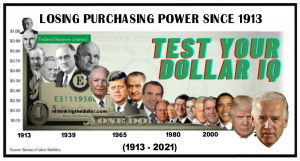Article originally appeared on Goldmoney.com (HERE)
Monetarists are fully aware that if a government increases the quantity of money in circulation, its purchasing power declines. Their theory is based on the days when gold was money and describes the effect of imports and exports of monetary gold on the general price level.
Pure monetarists appear to assume the same is basically true of fiat currencies, unbacked by gold. But there is a fundamental difference. When gold is used as money for settling cross-border trade, an arbitrage takes place, correcting price differentials. When prices are generally low in one country, that country would achieve sales of commodities and goods in other countries where prices were higher. Gold then flows to the lower price centre, raising its prices towards those of other countries. With unbacked national currencies, this does not happen.
Instead, national currencies earned through cross-border trade are usually sold in the foreign exchanges, and the determinant of trade flows is no longer an arbitrage based on a common form of money. The pure link between money and trade has gone, and whether foreigners retain or sell currency earned by exports depends mostly on their confidence in it. That is a matter for speculation, not trade.
Domestic users of state-issued currency are divorced from these issues, because foreign currencies do not circulate domestically as a medium of exchange. Instead of being a form of money accepted beyond national boundaries, as gold was formerly, there is no value anchor for domestic use. For this reason, a national currency’s purchasing power becomes a matter of trust, and it is that trust that risks being undermined in a credit crisis. The less trustworthy a government, the more rapidly a currency is in risk of decline.
 This is why monetarism, which was based on gold as ubiquitous money, is no longer the sole determinant of currency values. It is true that an increase in the quantity of circulating money devalues the existing stock, but if the population as a whole is prepared to increase its preference for money, usually expressed as a savings ratio, there need be no detrimental effect on its purchasing power.
This is why monetarism, which was based on gold as ubiquitous money, is no longer the sole determinant of currency values. It is true that an increase in the quantity of circulating money devalues the existing stock, but if the population as a whole is prepared to increase its preference for money, usually expressed as a savings ratio, there need be no detrimental effect on its purchasing power.
With fiat currencies we enter a world where statistics reflect the quantity of money, and never the confidence people have in it. Additionally, we should observe that statistics can tell you everything and nothing, but never the truth. It is possible for an economy to collapse, but statistically appear healthy as the following example illustrates.
Imagine, for a moment, that modern statisticians and their methods existed at the time of the Weimar Republic. Government finances were covered by approximately ten per cent taxes and ninety per cent monetary inflation. It was a government whose finances were run on the lines recommended by today’s modern monetary theorists.[i]
There can be no doubt the low level of taxation was an encouragement to business and permitted the redeployment of earnings for investment. A falling exchange rate delivers excess profits for export businesses as well. Interest rates were attractive relative to the rate of price inflation, and the economy, statistically anyway, was expanding rapidly.
This was certainly true measured in nominal GDP, the basic measure of economic activity today. Official prices, which are always the latest gathered and indexed, lag monetary debasement by at least a month, possibly two or even three. To this we must also mention governments always under-record price inflation, which is the natural consequence of earlier debasement. Therefore, even after an official price deflator is applied to nominal GDP, “real” GDP growth in Germany between 1918 and early-1923 would be judged by today’s government economists to be booming.
Interestingly, Joseph Stiglitz and a raft of left-leaning economists and politicians believed Hugo Chavez’s socialist policies were successful in 2007, when statistics revealed a similar interpretation for Venezuela’s inflation-ridden economy. However, instead of Germany being deemed to be in an economic boom, in 1920 economists in the classical and Austrian traditions saw it for what it was. Even Keynes wrote about it in his Tract on Monetary Reform, published coincidentally in late-1923 when the papiermark finally collapsed.
Germany’s inflation may have been a statistical success, but it concealed crippling wealth destruction through the transfer of wealth and wages from private individuals to the state through monetary debasement. As Lenin is reputed to have said, “The way to crush the bourgeoisie is to grind them down between the millstones of taxation and inflation.” 
In Germany, inflationary financing started before the First World War to finance a build-up of armaments. At the outbreak of war, gold convertibility was suspended, and the unbacked papiermarkbegan its inflationary drift. Exploiting the facility to issue valueless pieces of paper as currency and for the people to circulate them as legal tender became the principal source of government funds.
This trick worked until approximately May 1923. By then, the purchasing power of the mark had fallen consistently at a relatively even pace. It then took only seven months to lose all its purchasing power, when the public collectively realised what was happening, and manically dumped their marks for anything. It was the katastrophenhausse, or crack-up boom, the end of life for a state’s unbacked currency.
It was the pattern firmly established in all fiat currency collapses, which, besides the currencies in existence today, has happened to all of them throughout the history of post-barter trade, without any known exception. It is the familiar route along which the dollar and other paper currencies are travelling today. Now that we are entering a statistical slowdown in most major economies, Weimar-style financing is set to return to centre-stage. The fate for unbacked state currencies, unless somehow averted, will be the same.
The lesson from Weimar and today’s monetary inflation is that the period before the public cottons on to it can be prolonged. In Germany it was 1914-1923, followed by a swift seven-month collapse. Today it is from 1971 and still counting. But the final collapse could be as rapid as Germany’s between May and November 1923.
Doubtless, we will see rising price inflation later this year, but that statistic will continue to be suppressed. With the gap between the effect of accelerating monetary inflation and the official rate of price inflation widening, we could see for a brief period the statistical recovery in GDP that so badly misled Professor Stiglitz and others observing Venezuela’s economy twelve years ago.
Watch these top trending RTD videos to get the real scoop. (100k+ YouTube Views)
1) (We Are In A National Crisis) Did You Hear What Trump Said?
https://youtu.be/15hDwzkWnV8
2) Trump And A New Gold-Backed Dollar
https://youtu.be/PQzrtvEtTgw
3. RTD Ep:69 “A Reset Of All The Global Fiat Currencies Against Gold” – Kevin Massengill
https://youtu.be/IVZdSJ6zENI
[embedyt] https://www.youtube.com/watch?v=3OIAA5TTMn0[/embedyt]









0 Comments